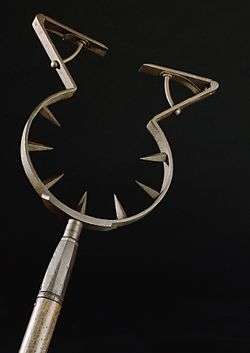Man catcher

A man catcher is an esoteric type of pole weapon which was used in Europe as late as the 18th century. It consisted of a pole mounted with a two pronged head. Each prong was semi-circular in shape with a spring-loaded "door" on the front. This created an effective valve that would allow the ring to pass around a man-sized cylinder and keep it trapped. The man catcher was used primarily to pull a person from horseback and drag them to the ground where they could be helplessly pinned. This is one of the few examples of non-lethal polearms.
Man catchers played a role in the medieval custom of capturing noble opponents for ransom. The design assumes that the captured person wears armor to protect him against the metal prongs, which could easily hurt the neck of a person without armor. The man catcher was also used to trap and contain violent prisoners.[1]
In Papua New Guinea, a different weapon existed that was also identified as a man catcher. It consisted of a hoop attached to a spear - the hoop would be placed over an enemy's head to capture them, and then they could be speared in the back of the neck.[2]
Similarly, the Japanese sodegarami, tsukubō, and sasumata were used by Edo era law enforcement for apprehending suspects. However, the sasumata was most like a man catcher in usage as its forked head was designed to pin the suspect's neck, legs, arms, or joints against a wall or the ground. While other man catchers are no longer in use, the sasumata currently has modern variants that are semi-flexible, with padding, blunt endpoints, and other slightly modified geometry, designed to significantly reduce the chance of injury to restrained civilians. These variants are designed for use by non-soldiers -- specifically, they are intended for use by a Japanese riot police mounted on horseback. In such a case, the mounted riot police would typically be arranged in formation line abreast, and would use a row of raised sasumata to hold back large crowds. These mounted riot police answer to the Japanese National Police Agency. Since the outbreak of serious riots is uncommon in Japan, the modern sasumata is only used rarely. Nevertheless, the necessary training is kept up to date.[3]
References
- ↑ http://www.makingthemodernworld.org.uk/everyday_life/control/1750-1820/TL.0151/
- ↑ http://www.abc.net.au/tv/collectors/txt/s1411700.htm
- ↑ Cunningham, Don. Taiho-jutsu:Law and Order in the Age of the Samurai. Boston; Rutland, Vermont; Tokyo: Tuttle Publishing, 2004.